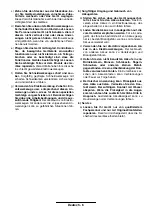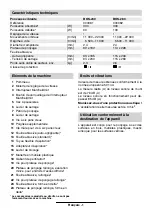
English - 2
Working safely with this ma-
chine is possible only when the
operating and safety information
are read completely and the in-
structions contained therein are
strictly followed. In addition, the
general safety rules in the safety
rules section must be observed.
■
Wear safety goggles.
■
The dust that is produced while working can be
detrimental to health, inflammable or explo-
sive. Suitable safety measures are required.
Examples: Some dusts are regarded as carci-
nogenic. Use suitable dust /chip extraction and
wear a dust respirator.
Dust from light alloys can burn or explode. Al-
ways keep the workplace clean, as blends of
materials are particularly dangerous.
■
If the mains cable is damaged or cut through
while working, do not touch the cable but im-
mediately pull the mains plug. Never use the
machine with a damaged cable.
■
Connect machines that are used in the open
via a residual current device (RCD) with an ac-
tuating current of 30 mA maximum. Use only
extension cables that are approved for outdoor
use.
■
The machine can be used only for dry sanding.
■
Insert the mains plug only when the machine is
switched off.
■
Always direct the cable to the rear away from
the machine.
■
Do not work with materials containing asbes-
tos.
■
Always switch the machine off and wait until it
has come to a standstill before placing it down.
■
Never allow children to use the machine.
■
Berner is only able to ensure perfect operation
of the machine if the original accessories in-
tended for it are used.
■
Before any work on the machine itself, pull
the mains plug.
Selecting the sanding disc
Depending on the material to be worked, different
sanding sheet qualities are to be used.
Replacing the Sanding Disc
Before placing on a new sanding sheet, free the
sanding plate from dust and dirt.
To ensure optimum dust extraction, the holes of
the sanding sheet must match with those of the
sanding plate.
Sanding Sheet with Velcro Attachment
(see figure
)
The sanding sheets are placed directly onto the
sanding plate. The hole pattern in the sanding
plate and sanding sheet must match.
Sanding Sheets without Velcro Attachment
(see figure
)
Lightly lift the clamping lever 6 and unlatch it.
Slide the sanding sheet 13 under the open
clamping bracket 8 (
➊
) and reinsert the clamping
lever 6 (
➋
).
Make sure that the sanding sheet 13 lies taut on
the sanding plate. Fold the sanding sheet around
and clamp the other end in the same manner.
Sanding sheets without holes, e. g. from rolls or
by the meter, can be punctured with the perforat-
ing tool 18* for use with dust extraction (see
figure ).
The standard sanding plate 7 with velcro backing
can be exchanged against various specialty
sanding plates (accessories).
For this, unscrew the six screws 19 with a screw-
driver and remove the sanding plate.
Attach the desired sanding plate and insert
screws 19, or 22 respectively, when using the
thin, extended sanding plate 20.
For Your Safety
Replacing the Sanding Disc
Replacing the Sanding Plate
(see figure
)
A
B
E
F













































